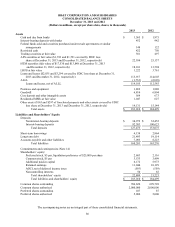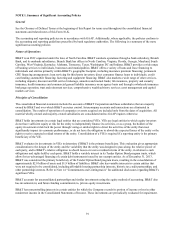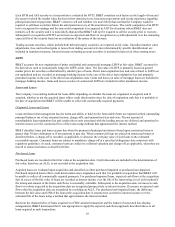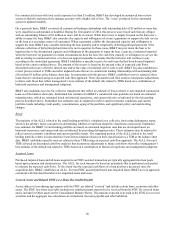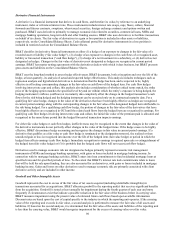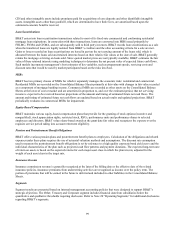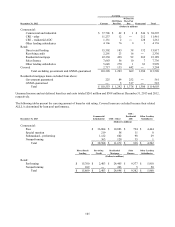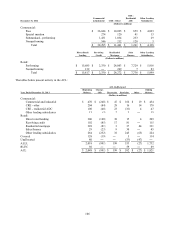BB&T 2013 Annual Report Download - page 96
Download and view the complete annual report
Please find page 96 of the 2013 BB&T annual report below. You can navigate through the pages in the report by either clicking on the pages listed below, or by using the keyword search tool below to find specific information within the annual report.
96
For commercial clients with total credit exposure less than $1 million, BB&T has developed an automated loan review
system to identify and proactively manage accounts with a higher risk of loss. The “score” produced by this automated
system is updated monthly.
On a quarterly basis, BB&T reviewed all commercial lending relationships with outstanding debt of $5 million or more that
were classified as substandard or doubtful. During the first quarter of 2014, this process was revised such that any obligor
with an outstanding balance of $3 million or more will be reviewed. While this review is largely focused on the borrower’s
ability to repay the loan, BB&T also considers the capacity and willingness of a loan’s guarantors to support the debt service
on the loan as a secondary source of repayment. When a guarantor exhibits the documented capacity and willingness to
support the loan, BB&T may consider extending the loan maturity and/or temporarily deferring principal payments if the
ultimate collection of both principal and interest is not in question. In these cases, BB&T may not deem the loan to be
impaired due to the documented capacity and willingness of the guarantor to repay the loan. Loans are considered impaired
when the borrower (or guarantor in certain circumstances) does not have the cash flow capacity or willingness to service the
debt according to contractual terms, or it does not appear reasonable to assume that the borrower will continue to pay
according to the contractual agreement. BB&T establishes a specific reserve for each loan that has been deemed impaired
based on the criteria outlined above. The amount of the reserve is based on the present value of expected cash flows
discounted at the loan’s effective interest rate and/or the value of collateral, net of costs to sell. BB&T has also established a
review process related to TDRs and other impaired loans that are in commercial lending relationships with outstanding debt
of less than $5 million at the balance sheet date. In connection with this process, BB&T establishes reserves related to these
loans that are calculated using an expected cash flow approach. These discounted cash flow analyses incorporate adjustments
to future cash flows that reflect management’s best estimate of the default risk related to TDRs based on a combination of
historical experience and management judgment.
BB&T also maintains reserves for collective impairment that reflect an estimate of losses related to non-impaired commercial
loans as of the balance sheet date. Embedded loss estimates for BB&T’s commercial loan portfolio are based on estimated
migration rates, which are estimated based on historical experience, and current risk mix as indicated by the risk grading
process described above. Embedded loss estimates may be adjusted to reflect current economic conditions and current
portfolio trends including credit quality, concentrations, aging of the portfolio, and significant policy and underwriting
changes.
Retail
The majority of the ALLL related to the retail lending portfolio is calculated on a collective basis using delinquency status,
which is the primary factor considered in determining whether a retail loan should be classified as nonaccrual. Embedded
loss estimates for BB&T’s retail lending portfolio are based on estimated migration rates that are developed based on
historical experience, and current risk mix as indicated by prevailing delinquency rates. These estimates may be adjusted to
reflect current economic conditions and current portfolio trends. The remaining portion of the ALLL related to the retail
lending portfolio relates to loans that have been deemed impaired based on their classification as a TDR at the balance sheet
date. BB&T establishes specific reserves related to these TDRs using an expected cash flow approach. The ALLL for retail
TDRs is based on discounted cash flow analyses that incorporate adjustments to future cash flows that reflect management’s
best estimate of the default risk related to TDRs based on a combination of historical experience and management judgment.
Acquired Loans
Purchased impaired loans and all loans acquired in an FDIC-assisted transaction are typically aggregated into loan pools
based upon common risk characteristics. The ALLL for each loan pool is based on an analysis that is performed each period
to estimate the expected cash flows. To the extent that the expected cash flows of a loan pool have decreased since the
acquisition date, BB&T establishes an ALLL. For non-FDIC assisted purchased non-impaired loans, BB&T uses an approach
consistent with that described above for originated loans and leases.
Covered Assets and Related FDIC Loss Share Receivable/Payable
Assets subject to loss sharing agreements with the FDIC are labeled “covered” and include certain loans, securities and other
assets. The FDIC loss share receivable includes net reimbursements expected to be received from the FDIC for covered loans
and is included in Other assets on the Consolidated Balance Sheets. The amounts expected to be paid to the FDIC for covered
securities and the aggregate loss calculation are included in Accounts payable and other liabilities.


